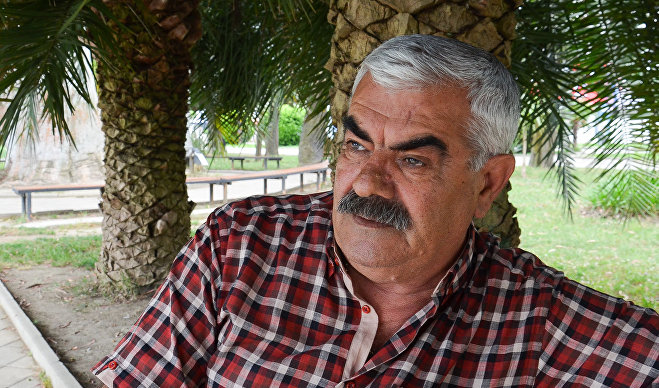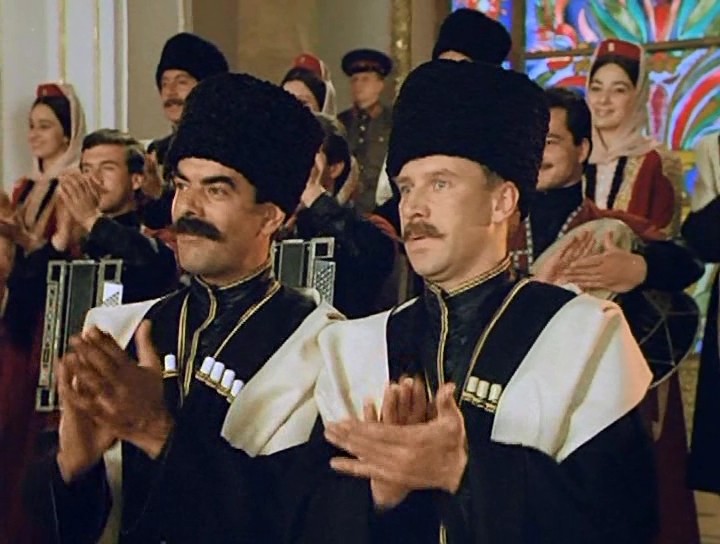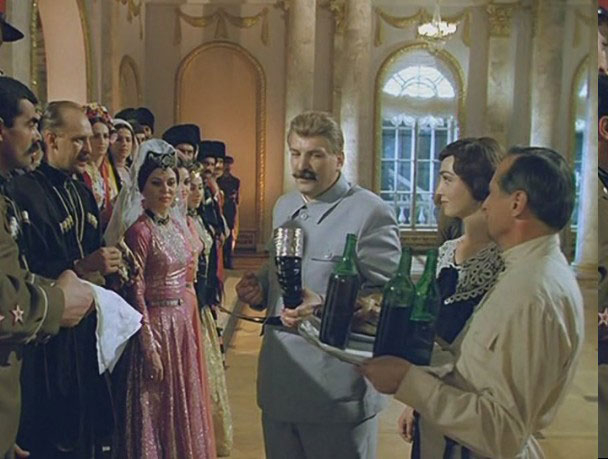Songs, Dances and Wine: How "[Dance-ensemble] Sharatyn" Spent the Night with Stalin

'The Feasts of Belshazzar, or a Night with Stalin' is a 1989 film adaptation of Fazil Iskander's eponymous novella.
The film-exposé "Belshazzar’s Feast, or Night with Stalin", based on the work of Fazil Iskander "Sandro from Chegem", saw the light of day on 1 June 1989.
Shooting of the film began in Abkhazia, but the main scene, the feast of the Supreme Leader of the People and his acolytes, where the tables were bursting with refreshments, while the dances and songs of the Abkhazian artists forced applause from the managers of the Soviet Union as they stood on their feet, was filmed in one of the studios of Mos-Film.
National artist of Abkhazia, Vakhtang Vozba, who played the role of Makhaz as part of the legendary ensemble "Sharatyn", told the Sputnik correspondent what remained off camera -- why he had to drink two horn-fulls of wine in a row during the very filming and who in the dance actually “slid up" at the feet of Stalin.
"Natural" selection and first takes
The search for a dance-collective for the filming of the main episode of the film "Belshazzar’s Feast, or Night with Stalin" was conducted throughout Abkhazia. The selection was thorough, as the artists had to add adornment to the feast, fake though it be, for Joseph Stalin himself! Everything had to be natural, but at the same time full of virtuosity.

Vakhtang Vozba, National artist of Abkhazia
“Sharatyn” marvellously met all requirements. The feature of this ensemble was its versatility, since the artists were masters of almost all Caucasian dances, and further searches were simply no longer needed. Yuri Kara made his choice and his calculation proved to be correct.
There were no special requirements for great acting ability, but those who watched this film certainly drew attention not only to the honed choreography of the Sharatynians, but also to how each of them played their minor roles.
Personally, I finally became convinced of this when, preparing to meet with the People's Artist of Abkhazia Vakhtang Vozba, I once again reviewed what was a sensational film for its time.
+ People's Artist of Abkhazia Vakhtang Vozba passes away
Vozba shared his memories of how shooting went in Abkhazia. The first episode involving the participation of the dancers of the Sharatyn ensemble, which was presented in the film as Platon Pantsulaia’s song and dance ensemble of Abkhazia, was shot in the square near the Republic’s State Drama Theatre, where a monument to Stalin was erected within one day, which greatly surprised the residents of the capital.
“The moment when we walked to the hall where Stalin and other leaders of the USSR were holidaying, took only a few seconds in the film, but in fact, they shot it in three different places. One moment was in Stalin’s dacha up from Lake Ritsa, then it was in the hall of the Drama Theatre, and finally the feast itself took place at Mos-Film. In addition, there were scenes shot at one of the Gagra sanatoriums, also on the Bzyp bridge and even in Yalta," Vakhtang Vozba said.
Vakhtang Vozba (Right)
Not just a game
To shoot the main scene of the film, the artists of “Sharatyn” had to move to Moscow for a whole month, and they remembered this time for the rest of their lives. The festive table, which is impossible to watch without salivating, was updated daily with fresh dishes. Everything lying there, except the fruit, Vozba stressed, was real.
Two days before leaving for Moscow, Vakhtang Vozba was called by the director Yuri Kara and asked to bring for filming some bottles of Abkhazian wine and a horn, the capacity of which was to be at least one litre. At that time Vozba still did not know what ordeal lay ahead of him...
After the feast was over, according to the script, Stalin came up to Makhaz and gave him a full horn of wine, which he needed not only to drink but to do so with such artistry that the viewer would understand what he was feeling at that moment. At first, he failed to get into the role.
“The director set me up for this scene. He said: ‘Just imagine that Stalin himself is filling the horn for you, and you should drink it with a solid attitude, under pressure, and then show the audience that you are happy and inspired that the supreme leader of the people offered the horn just to you.’ And I’m thinking — what problems can there be? Without spilling a drop, without pausing, I almost emptied the wine in the horn with its litre-capacity when the director orders that filming be stopped!" Vozba said.
Yuri Kara was dissatisfied, and after about ten minutes another horn was filled for Vakhtang Vozba. He tried to refuse but failed. Second take.
“And my friends, who were standing behind me, were adding to the pressure. ‘Don’t disgrace us, because Stalin is in front of you’, they whispered behind me. I gathered myself together and began to drain that wine-filled horn with such zeal that drops of drink flowed down my chin. At that moment, out of the corner of my eye, I saw the approving gesture of the director and his contented face. ‘Stop! It’s in the can!’ he shouted," said Vozba, sharing this curious moment.

“The next horn Stalin presented to Sandro, who was played by Alexandr Feklistov. It was simpler in this case, as they filled the horn for the eminent Soviet actor with juice instead of wine, although Feklistov was counting on a rather stronger beverage!” a little cunning trick revealed by Vozba.
The efforts and skill of Vakhtang Vozba were rewarded with a privilege in the shape of a couch, with which he had already been imposingly watching the filming process and the talented performance of the star-cast of actors:
“Alexandr Feklistov - Sandro, Aleksej Petrenko in the role of Stalin, Sergej Nikonenko as Voroshilov, Aleksej Safonov as Nestor Lakoba, Valentin Gaft in the role of Lavrenti Beria, Tamara Jandieva who played Saria Lakoba - all of them were remembered not only as brilliant actors, but also as good, simple people with whom the ensemble "Sharatyn" became friends. The dancers would speak about this in Abkhazia with pride,” Vozba acknowledged.
According to the recollections of the Sharatyn member, the performance of these artists was so believable and sincere that sometimes it seemed to him that the historical figures being portrayed really came to life before him, and this made him plunge into the atmosphere of that period.
There is a scene in the film when, at the request of Joseph Stalin, Nestor Lakoba demonstrates his talent as a shooter and, as shared by Vozba, at that moment he experienced a special pride in this legendary man and in the entire Abkhazian people.
The national artist of the republic is sure that it was impossible to choose the best of the acting cast.
“Each of them performed so vividly that a viewer could feel what was happening in the very soul and thoughts of the heroes of the picture. Envy, hypocrisy, cruelty, joy, emotional experience and styles of behaviour – they were all conveyed brilliantly. Bring to mind the moment when Saria reacted kindly to a youth who almost became a target during those shootings, and Beria was so envious of Lakoba that it was even visible in the film," said Vozba.
And Stalin’s phrase that Abkhazian Adzhika has a great future, Vozba added, was prophetic.
"Ashkjaraz" before Stalin
Without the fiery Caucasian dances the film “Belshazzar’s Feast, or Night with Stalin” would certainly not be so spectacular and interesting, but the ensemble “Sharatyn” did everything to prevent this from happening.
The famed "ashkjaraz" (slide - ed.), which in the film was performed by Feklistov in the role of Sandro, when he slid up to Stalin and stopped a few metres from his feet, was rehearsed for days.
“We taught him how to slide in the dance, but he naturally couldn’t keep it up over such a distance. Therefore, it was Lavrenti Tsikolia who performed the start of the “ashkjaraz”, whilst it was Feklistov who appeared as the movement came to a stop at Stalin’s feet. Cinema allows one to use such filming techniques,” was the secret Vozba shared, adding with regret that after shooting the film they saw Feklistov and director Kara only once more.
Two solo-dances were performed by Vakhtang Vozba in the role of Makhaz in this film. One of them, the Abkhazian dance, he performed with Saria.
“We ran through this dance with Tamara Jandieva for three days. Then I had a dance on tip-toe, which, of course, was not difficult, since it was part of the concert-programme of our ensemble,” Vozba noted.
Director of the film, Yuri Kara, expected from the Sharatyn collective not only dances but also songs. Despite the fact that this was not their speciality, the artists sang precisely as the main director required. Vozba revealed another secret to Sputnik, which is known to only a narrow circle of people.
“Do you recall the moment when they start to sing the song ‘Smyr Gudisa’ at the table? Viacheslav Kapba is in the shot, but I am the one singing it,” said Makhaz, letting us into his secret.
Full film: "Belshazzar’s Feast, or Night with Stalin"(1989)
“A month flew by like a flash. The ensemble from Abkhazia returned home, but already completely changed. Work with the masters of Soviet cinema made them take a fresh look at life and themselves. They seemed to feel a responsibility to those people with whom they created one of the best Soviet films and tried to live up to this level,” the People's Artist of Abkhazia acknowledged.
The film " Belshazzar’s Feast, or Night with Stalin" was shot in 1989, but it did not go on release to Soviet cinemas for a long time. Vakhtang Vozba and his colleagues managed to view the tape only in 1992, when one of their friends sent a video-cassette from Finland.
This article was published by Sputnik Abkhazia and is translated from Russian.